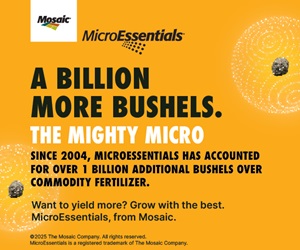Keys to becoming 100% continuous no-till
.
“I’ve heard it said that you never want corn to have a bad day,” says Grant Troop, a Pennsylvania farmer who recently spoke at the Innovative Farmer’s Conference in London, Ontario. But making sure corn has a great day everyday isn’t as easy as it sounds, especially if your goal is to eventually become a 100% continuous no-till operation.
Troop’s presentation offered three key strategies for producing high-yield, no-till crops, while developing good soil structure to promote vigorous plant growth. He discussed the value of two-zone placement for starter fertilizer, the importance of implementing fertility practices and how no-till planter setups work. During the breakout sessions, he also discussed cover crops and practices that hinder their growth.
Troop says that two-zone placement is fairly unique, but it’s something that he has come to think of as extremely reliable. When working with corn, he says, there are very specific steps that must be taken at just the right time. Until it has its first leaf, all of the plant’s nutrients are coming from the seed, he says. Once it hits the two-leaf stage, it starts taking nutrients from around the seed – something that doesn’t work so well in no-till soil since it tends to be colder.
“It’s very important to put an available source of nutrient right in that seed for that seed root to take up because the demand for phosphorus is higher per unit of plant tissue than at any other time during the growth cycle,” says Troop. “If you have it limited there, you’re going to limit the crop out somewhere else in the growing season.”
Once corn hits the three and four-leaf stage, the roots start to spread out so that they hit the band of fertilizer that’s two inches away. “It’s important to have that because that three to four leaf stage is when the corn is determining how many kernels it can possibly have on an ear,” says Troop. “It’ll never be more than what it determines at that three to four leaf size.”
In order to run a successful no-till operation, Troop says farmers need to think about their equipment as well.
“What we’re trying to do in the Northern growing areas is take the planter and use a residue manager or row-cleaner to clear surface residue from the row area so you get some soil warming, and then use a type of no-till coulter to give you a little bit of loose soil,” says Troop. The idea is to warm the band of soil around the seed – quickly and early – so you can get that crop started. “If those things happen,” he says, “no-till can often be quite successful.”
There’s no doubt, cover crops play a strong role in maintaining healthy soil, particularly in no-till operations. During the breakout sessions, Troop looked at why cover crops sometimes don’t do as well as expected. From his experience, residue from herbicides that have been applied to previous crops can interfere with the growth of the cover crop.
“If they want to be successful in cover cropping they need to pay attention to their herbicide program,” says Troop. He suggests that farmers avoid long residual and immediate residual herbicides and use short residual herbicides instead. “Maybe a few specifically chosen medium residual herbicides and then do a couple overlapping applications,” he says. “We can end up at the end of the growing season with very little or no residue, that way it’s not going to be held back by herbicide residues from the previous crop.”
At the end of his presentation, a number of grain farmers approached Troop and asked him about the additives he puts in his liquid start-up fertilizer. It wasn’t until then that it dawned on Troop that even though those types of products have been available in the U.S. for over a decade, they currently aren’t available in Canada. He’s now working with AgXplore International to see if they can get some of those products approved here.
“Those products are designed to speed early growth and development, and I think that’s a very important component in Ontario,” says Troop. “Anything you can do to speed things along, it’s going to be possible to then maybe do some more of the cover crops and the types of things we’re trying to do to really make no-till work well.” •

















